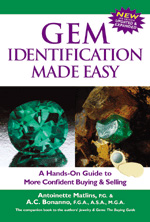 If you own valuable jewelry, you probably worry about it when you leave home – and if you take it with you, you worry even more. Ordinary insurance will only cover so much if your jewelry is stolen, so I asked jewelry expert Antoinette Matlins what she recommends. As always, I learned all kinds of useful things from her.
If you own valuable jewelry, you probably worry about it when you leave home – and if you take it with you, you worry even more. Ordinary insurance will only cover so much if your jewelry is stolen, so I asked jewelry expert Antoinette Matlins what she recommends. As always, I learned all kinds of useful things from her.
A gemologist, consumer affairs specialist and author of several guides for buying jewelry, diamonds and gems (many of which I own and recommend), Antoinette is also a jewelry collector and connoisseur herself. So she knows firsthand how to keep valuable jewels safe.
What is the first step to insuring a jewelry collection?
Verify that what you have is, in fact, what it’s represented to be. Hopefully, collectors are doing that with each piece they buy, but all too often, people assume jewelry is what the seller claims, especially if they’re buying from a respected source. Have each piece examined by someone who is a gemologist as well as an appraiser, who can confirm the quality and issue a valuation.
Don’t rely solely on auction house specialists. They operate on the assumption that you will be selling a piece through them eventually, so estimates are based on their own comparable sales and reserve (the lowest price at which something can be sold). If you go to an auction house, bring an appraiser.
Which insurance companies do you recommend?
Chubb is one of finest insurance companies for gems and jewelry. Many of my clients are insured through them and several have recovered from significant losses without any problems. Jewelers Mutual offers a viable alternative in terms of insuring your jewelry. A policy from them is not tied to the rest of your personal property insurance – which means that if a major theft occurs, you won’t be facing a higher premium on all your personal property.
What should collectors keep in mind when shopping for insurance?
Rates will differ depending on where you are. Compare the coverage and premiums from a variety of different sources. Find out what coverage you already have. For example, people can get diamond coverage for a ring but when they try to collect, the insurance company gives them a replacement or cash settlement at some reduced amount. Insurance companies may want to replace the ring because it can save money. You may not be dealing with someone who understands the unique cut or other qualities that make your diamond special.
What if I collect something unusual, like studio jewelry that lacks the kind of intrinsic value an insurer would understand?
Collectors who are buying rare, sometimes irreplaceable jewelry or gemstones, in my professional opinion, should seek an insurer who provides a cash policy. If something is stolen and it’s worth $100,000, they will give you a check for $100,000. That’s very different from a replacment-type policy. A fabulous Art Nouveau or Deco piece by a major name with certain recognizable details will hopefully resurface, but if it doesn’t, you don’t want to rely on the insurance company to figure out what it’s worth.
Have a specific question about insuring your jewelry? Ask it in the comments, and we’ll pass it along to the expert.
Related products:


